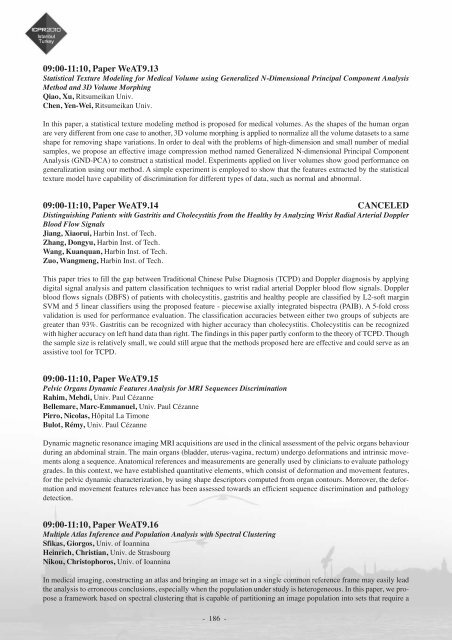Abstract book (pdf) - ICPR 2010
Abstract book (pdf) - ICPR 2010
Abstract book (pdf) - ICPR 2010
- TAGS
- abstract
- icpr
- icpr2010.org
You also want an ePaper? Increase the reach of your titles
YUMPU automatically turns print PDFs into web optimized ePapers that Google loves.
09:00-11:10, Paper WeAT9.13<br />
Statistical Texture Modeling for Medical Volume using Generalized N-Dimensional Principal Component Analysis<br />
Method and 3D Volume Morphing<br />
Qiao, Xu, Ritsumeikan Univ.<br />
Chen, Yen-Wei, Ritsumeikan Univ.<br />
In this paper, a statistical texture modeling method is proposed for medical volumes. As the shapes of the human organ<br />
are very different from one case to another, 3D volume morphing is applied to normalize all the volume datasets to a same<br />
shape for removing shape variations. In order to deal with the problems of high-dimension and small number of medial<br />
samples, we propose an effective image compression method named Generalized N-dimensional Principal Component<br />
Analysis (GND-PCA) to construct a statistical model. Experiments applied on liver volumes show good performance on<br />
generalization using our method. A simple experiment is employed to show that the features extracted by the statistical<br />
texture model have capability of discrimination for different types of data, such as normal and abnormal.<br />
09:00-11:10, Paper WeAT9.14 CANCELED<br />
Distinguishing Patients with Gastritis and Cholecystitis from the Healthy by Analyzing Wrist Radial Arterial Doppler<br />
Blood Flow Signals<br />
Jiang, Xiaorui, Harbin Inst. of Tech.<br />
Zhang, Dongyu, Harbin Inst. of Tech.<br />
Wang, Kuanquan, Harbin Inst. of Tech.<br />
Zuo, Wangmeng, Harbin Inst. of Tech.<br />
This paper tries to fill the gap between Traditional Chinese Pulse Diagnosis (TCPD) and Doppler diagnosis by applying<br />
digital signal analysis and pattern classification techniques to wrist radial arterial Doppler blood flow signals. Doppler<br />
blood flows signals (DBFS) of patients with cholecystitis, gastritis and healthy people are classified by L2-soft margin<br />
SVM and 5 linear classifiers using the proposed feature - piecewise axially integrated bispectra (PAIB). A 5-fold cross<br />
validation is used for performance evaluation. The classification accuracies between either two groups of subjects are<br />
greater than 93%. Gastritis can be recognized with higher accuracy than cholecystitis. Cholecystitis can be recognized<br />
with higher accuracy on left hand data than right. The findings in this paper partly conform to the theory of TCPD. Though<br />
the sample size is relatively small, we could still argue that the methods proposed here are effective and could serve as an<br />
assistive tool for TCPD.<br />
09:00-11:10, Paper WeAT9.15<br />
Pelvic Organs Dynamic Features Analysis for MRI Sequences Discrimination<br />
Rahim, Mehdi, Univ. Paul Cézanne<br />
Bellemare, Marc-Emmanuel, Univ. Paul Cézanne<br />
Pirro, Nicolas, Hôpital La Timone<br />
Bulot, Rémy, Univ. Paul Cézanne<br />
Dynamic magnetic resonance imaging MRI acquisitions are used in the clinical assessment of the pelvic organs behaviour<br />
during an abdominal strain. The main organs (bladder, uterus-vagina, rectum) undergo deformations and intrinsic movements<br />
along a sequence. Anatomical references and measurements are generally used by clinicians to evaluate pathology<br />
grades. In this context, we have established quantitative elements, which consist of deformation and movement features,<br />
for the pelvic dynamic characterization, by using shape descriptors computed from organ contours. Moreover, the deformation<br />
and movement features relevance has been assessed towards an efficient sequence discrimination and pathology<br />
detection.<br />
09:00-11:10, Paper WeAT9.16<br />
Multiple Atlas Inference and Population Analysis with Spectral Clustering<br />
Sfikas, Giorgos, Univ. of Ioannina<br />
Heinrich, Christian, Univ. de Strasbourg<br />
Nikou, Christophoros, Univ. of Ioannina<br />
In medical imaging, constructing an atlas and bringing an image set in a single common reference frame may easily lead<br />
the analysis to erroneous conclusions, especially when the population under study is heterogeneous. In this paper, we propose<br />
a framework based on spectral clustering that is capable of partitioning an image population into sets that require a<br />
- 186 -



